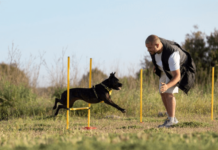Last Updated on April 1, 2024 by Dogs Vets
Master 7 Essential Dog Training Commands Easily
Training your dog is not only a way to ensure their safety and well-being, but it also strengthens the bond between you and your furry friend.
Teaching your dog essential commands is an important part of their development and can make your life as a pet owner much easier.
In this article, we will explore the top 7 commands that every dog should know, and provide you with valuable tips on how to train your dog effectively.
1. Sit Command
The “sit” command is one of the first commands you should teach your dog.
It is a fundamental command that sets the foundation for other commands and helps establish control and discipline.
To train your dog to sit, follow these simple steps:
- Hold a treat close to your dog’s nose.
- Slowly move your hand up, allowing their head to follow the treat and causing their bottom to lower.
- Once they are in a sitting position, say “sit” and give them the treat and praise.
Repeat this process several times a day until your dog responds consistently to the “sit” command.
2. Stay Command
The “stay” command is crucial for keeping your dog safe in various situations. It teaches them to remain in one place until you give them permission to move.
Here’s how you can train your dog to stay:
- Start with your dog in a sitting position.
- Hold your hand up, palm facing your dog, and say “stay” in a firm but calm voice.
- Take a step back and wait for a few seconds.
- If your dog stays in place, reward them with a treat and praise.
- Gradually increase the distance and duration of the “stay” command over time.
Consistency is key when training your dog to stay. Practice the command in different environments and gradually introduce distractions to ensure they can stay focused.
3. Come Command
The “come” command is essential for keeping your dog safe and under control, especially in outdoor environments. It teaches them to return to you when called.
Follow these steps to train your dog to come:
- Attach a long leash to your dog’s collar.
- Get down to their level and say “come” in an enthusiastic tone.
- Gently pull on the leash to guide them towards you.
- When they reach you, reward them with praise and treats.
Practice the “come” command in a safe and enclosed area before gradually introducing it in more distracting environments. Always reward your dog for coming to you, as it reinforces positive behavior.
4. Down Command
The “down” command teaches your dog to lie down on command. It is useful for various situations, such as keeping them calm in public spaces or during meals. Here’s how you can train your dog to lie down:
- Start with your dog in a sitting position.
- Hold a treat in your hand and place it in front of their nose.
- Slowly lower your hand to the ground, allowing them to follow the treat.
- Once they are in a lying position, say “down” and give them the treat.
Repeat this process consistently, gradually phasing out the treat rewards and relying more on verbal praise. Remember to be patient and reward your dog for their progress.
5. Leave It Command
The “leave it” command is crucial for keeping your dog safe from potentially harmful objects or substances. It teaches them to refrain from picking up or engaging with something you want them to avoid.
Follow these steps to train your dog to leave it:
- Show your dog a treat in your closed hand.
- Allow them to sniff and lick your hand but do not open it.
- Say “leave it” in a firm tone.
- Once they stop trying to get the treat, reward them with a different treat from your other hand.
Practice the “leave it” command with various objects and gradually increase the difficulty level. This command can potentially save your dog from ingesting harmful substances or objects while out on walks.
6. Off Command
The “off” command is essential for teaching your dog to keep their paws off people, furniture, or other objects. It establishes boundaries and helps prevent unwanted behavior. Here’s how you can train your dog to understand the “off” command:
- When your dog jumps on you or an object, calmly say “off” in a firm voice.
- Turn away from your dog and ignore them.
- Once they have all four paws on the ground, reward them with praise and attention.
Consistency is key when training your dog to understand the “off” command. Ensure that everyone in your household follows the same approach to prevent confusion.
7. Heel Command
The “heel” command teaches your dog to walk calmly by your side without pulling on the leash. It is particularly useful during walks or in crowded areas.
Follow these steps to train your dog to heel:
- Start with your dog on a leash.
- Hold the leash close to your body with your dog on your left side.
- Begin walking, and if your dog starts to pull, stop and say “heel” in a firm tone.
- Wait for them to come back to your side and continue walking.
Gradually increase the duration and distance of the “heel” command, rewarding your dog for walking calmly by your side. Consistency and positive reinforcement are key to successful leash training.
Conclusion
Training your dog to follow essential commands is a rewarding and necessary part of pet ownership. The top 7 commands discussed in this article – sit, stay, come, down, leaveit, off, and heel – will help ensure the safety and well-being of your dog while strengthening your bond.
Remember to be patient, consistent, and use positive reinforcement during the training process. With time and practice, your dog will become a well-behaved and obedient companion.
Frequently Asked Questions
1. How long does it take to train a dog?
The time it takes to train a dog varies depending on various factors such as the dog’s breed, age, and previous training experiences. Consistency, patience, and positive reinforcement are key to successful training.
2. Can I train an older dog?
Yes, you can train an older dog. While it may take more time and patience, older dogs can still learn new commands and behaviors with proper training techniques.
3. What if my dog doesn’t respond to the training?
If your dog doesn’t respond to the training, it may be helpful to seek guidance from a professional dog trainer or behaviorist. They can assess the situation and provide tailored strategies to address any challenges you may be facing.
4. Should I use punishment during training?
No, it is not recommended to use punishment during training. Positive reinforcement, such as treats, praise, and rewards, is a more effective and humane way to encourage desired behaviors in your dog.
5. Can I train my dog without professional help?
Yes, many dog owners successfully train their dogs without professional help. However, if you are facing difficulties or need guidance, consulting a professional dog trainer can be beneficial.
6. How often should I train my dog?
Consistency is key when training your dog. Short, frequent training sessions (around 10-15 minutes) several times a day are more effective than long, infrequent sessions.
7. Can I train my dog using only verbal commands?
Verbal commands are an essential part of dog training, but they can be reinforced with visual cues and hand signals.
Combining verbal and visual commands can enhance your dog’s understanding and response to the training.
Remember to always prioritize your dog’s well-being and make training sessions enjoyable for both of you. With patience, consistency, and positive reinforcement, you can effectively train your dog and strengthen your bond.
References:
Fact Check
We strive to provide the latest valuable information for pet lovers with accuracy and fairness. If you would like to add to this post or advertise with us, don’t hesitate to reach us. If you see something that doesn’t look right, contact us!

















